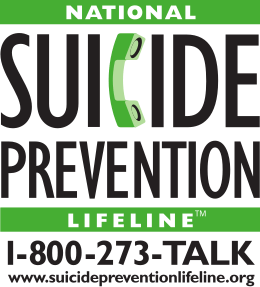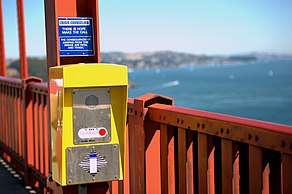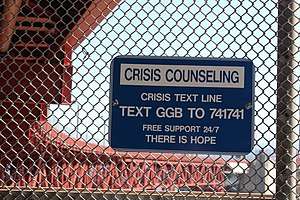Crisis hotline
A crisis hotline is a phone number people can call to get immediate emergency telephone counseling, usually by trained volunteers. The first such service was founded in England in 1953 and such hotlines have existed in most major cities of the English speaking world at least since the mid-1970s. Initially set up to help those contemplating suicide, many have expanded their mandate to deal more generally with emotional crises. Similar hotlines operate to help people in other circumstances, including rape, bullying, runaway children, human trafficking, and people who identify as LGBT or intersex. Despite crisis hotlines being common, their effectiveness in reducing suicides is unclear.[1][2]

| Suicide |
|---|
|
Social aspects |
|
Related phenomena |
|
Organizations |
Effectiveness
Even though crisis hotlines are common, they have not been well studied.[1][2] One study found that people's thoughts of suicide decreased during a call to a crisis line, and were lessened for several weeks after their call.[3]
One criticism of suicide hotlines was that those who were determined to kill themselves were unlikely to call one. Also, those with social anxiety may not have the emotional resources to do so. Some callers frequently call crisis helplines.[4]
History
Such services began in 1953, when Chad Varah, an English vicar, founded The Samaritans service, which soon established branches throughout the United Kingdom. The first Samaritans branch in the United States was established in Boston in 1974.[5] In addition to Boston, there are currently Samaritan branches in Falmouth, Massachusetts (serving the Cape Cod and Islands area),[6] the Merrimack Valley,[7] and the Fall River/New Bedford area.[8] Outside of Massachusetts, there are branches in New York City,[9] Providence,[10] Hartford,[11] Albany,[12] and Keene, New Hampshire.[13]
In the United States, the Los Angeles Suicide Prevention Center was founded in 1958 and was the first in the country to provide a 24-hour suicide prevention crisis line and use community volunteers in providing hotline service.[14] San Francisco Suicide Prevention[15] started a hotline named "Call Bruce" in 1962. A similar service, Lifeline, was established in Australia in 1963.
Another service, the volunteer-run crisis helpline Lifelink Samaritans Tas. Inc, originally called Launceston Lifelink, was established in Tasmania in 1968 by concerned citizens of Launceston, Tasmania who decided to create a phone service based on the principles of The Samaritans. The rationale was that people often become suicidal because they cannot discuss their emotional pain with family and friends.
This service provides emotional support 24 hours a day to people throughout Tasmania and does not have any religious affiliations. The organization is a member of Befrienders Worldwide and has a "twinning" relationship with Northampton Samaritans in the UK. Lifelink Samaritans is the oldest telephone befriending service in Tasmania and the fourth oldest in Australia and receives at least 5,000 calls a year.
Telephone counseling

Telephone counseling and crisis hotlines provide a similar telephone support service, and both usually accept crisis and non-crisis calls. In the United States, many college campuses have established telephone counseling lines serviced by student volunteers to compensate for the high demand placed on college mental health services. These hotlines serve callers in crisis, but also serve to provide a listening ear for people who "just need to talk." Typically, hotlines are staffed by volunteers, and are not intended to replace professional, long-term counseling services. They are rather intended to carry callers through an immediate situation. Such hotlines exist at the University of Maryland,[16] the University of Minnesota, [17] Tufts University,[18] Columbia University,[19] Cornell University,[20] Drexel University,[21] Caldwell University,[22] and Texas A&M University.[23]
The term "emotional support helpline" is sometimes used – which does not imply crisis or counseling, and can include email and text messaging. Such services have allowed for the wider dissemination of resources for people facing mental health crises.
With developments in mobile telephony, the use of text or SMS (short message service) has been utilized by counseling services. Youthline, a youth-oriented crisis helpline in New Zealand, began providing a text messaging counseling support line in 2004. [24]
Contact details
| Hotline/Resource | Organization/Purpose/Focus | Country |
|---|---|---|
| 13 11 14 | Lifeline offers 24/7 crisis support and suicide prevention services by phone. The organisation also has an online chat service[25] | Australia |
| 1300 659 467 | The Suicide Call Back Service is a nationwide service that provides professional 24/7 telephone and online counselling to people who are affected by suicide. In addition, the organisation also provides online chat and video chat services[26] | Australia |
| 1300 22 4636 | Beyond Blue provides nationwide information and support regarding anxiety, depression, and suicide. The helpline is available 24 hours a day, 7 days a week. In addition, the organisation also provides online chat from 3 pm to 12 am every day.[27] | Australia |
| 1800 55 1800 | Kids Helpline is a 24-hour nationwide service that provides access to crisis support, suicide prevention and counselling services for Australians aged 5–25. In addition the Kids Helpline does also provide online chat services.[28] | Australia |
| sociedadeamigosdavida.org.br | Amigos da Vida (Brazil)[29] | Brazil |
| 0155 5259-8121 | Consejo Psicológico e Intervención en Crisis por Teléfono (SAPTEL) is available 24 hours a day, 365 days a year. | Mexico |
| The Lowdown | A New Zealand project aimed at young New Zealanders suffering from Depression | New Zealand |
| 116 123 | Samaritans provides a hotline providing emotional support in the UK and Ireland. | United Kingdom, Ireland |
| 1-800-273-TALK (1-800-273-8255) |
The National Suicide Prevention Lifeline,[30] a 24/7 hotline for callers in the United States | United States |
| 1-800-799-4TTY (1-800-799-4889) |
TDD/TTY services at the National Suicide Prevention Lifeline | United States |
| 1-800-RUNAWAY (1-800-786-2929) |
National Runaway Safeline, hotline and live chat for runaway, homeless, and at-risk youth | United States |
| 800-273-TALK (800-273-8255) Then press 1 when prompted |
US Veterans Crisis Hotline[31] | United States |
| 866-48-TREVOR (866-488-7386) |
An American hotline aimed principally at LGBT teenagers, run by The Trevor Project[32] | United States |
| 1-866-SPEAK-UP (1-866-773-2587) |
American anonymous youth violence reporting hotline created by The Center to Prevent Youth Violence[33] | United States |
| 1-800-448-3000 | The Boys Town National HotlineSM is open 24 hours a day, 365 days a year, and is staffed by specially trained Boys Town counselors. | United States |
| veteranscrisisline.net | US Veterans Online chat and information | United States |
| 741-741 (United States) 686-868 (Canada) 85258 (United Kingdom) |
A free, 24/7 SMS Hotline providing emotional support for those in crisis provided by Crisis Text Line. In Canada, the service is also provided with a partnership by Kids Help Phone. In the U.K, Shout, an affiliate to the hotline that was founded by the Royal Foundation, operates in the U.K. | United States, Canada, United Kingdom |
The Volunteer Emotional Support Helplines (VESH) represents 1200 member centres in 61 countries. It has been formed by:
- Befrienders Worldwide[34] (maintained by the Samaritans UK)
- IFOTES – International Federation of Telephone Emergency Services[35]
- Lifeline International[36]
See also
- Hotline
- Complaint system
- List of counseling topics
- Telephone counseling
- Crisis Hotline: Veterans Press 1 (2013 documentary film)
References
- Sakinofsky I (June 2007). "The current evidence base for the clinical care of suicidal patients: strengths and weaknesses". Canadian Journal of Psychiatry. 52 (6 Suppl 1): 7S–20S. PMID 17824349.
Other suicide prevention strategies that have been considered are crisis centres and hotlines, method control, and media education... There is minimal research on these strategies. Even though crisis centres and hotlines are used by suicidal youth, information about their impact on suicidal behaviour is lacking.
- Zalsman G, Hawton K, Wasserman D, van Heeringen K, Arensman E, Sarchiapone M, et al. (July 2016). "Suicide prevention strategies revisited: 10-year systematic review". The Lancet. Psychiatry. 3 (7): 646–59. doi:10.1016/S2215-0366(16)30030-X. PMID 27289303.
Other approaches that need further investigation include gatekeeper training, education of physicians, and internet and helpline support.
- Preventing Suicide: A Technical Package of Policy, Programs, and Practices (PDF). CDC. 2017. p. 7. Retrieved December 3, 2019.
- Middleton, Aves; Gunn, Jane; Bassilios, Bridget; Pirkis, Jane (February 11, 2014). "Systematic review of research into frequent callers to crisis helplines". Journal of Telemedicine and Telecare. 20 (2): 89–98. doi:10.1177/1357633X14524156.
- Samaritanshope.org Archived October 3, 2008, at the Wayback Machine
- "Capesamaritans.org". Capesamaritans.org. September 24, 2011. Retrieved November 20, 2011.
- Familyserviceinc.com Archived September 26, 2008, at the Wayback Machine
- "Samaritans-fallriver.org". Samaritans-fallriver.org. August 26, 2011. Retrieved November 20, 2011.
- "Samaritansnyc.org". Samaritansnyc.org. Retrieved November 20, 2011.
- "Samaritansri.org". Samaritansri.org. Retrieved November 20, 2011.
- Suicidology.org Archived July 8, 2007, at the Wayback Machine
- Orgsites.com Archived January 27, 2009, at the Wayback Machine
- "Volunteersolutions.org". Volunteersolutions.org. January 20, 2011. Archived from the original on March 4, 2009. Retrieved November 20, 2011.
- "Brief History of Suicide Prevention in the United States". National Center for Biotechnology Information, U.S. National Library of Medicine. Retrieved May 10, 2015.
- "The SFSP Website". Sfsuicide.org. October 25, 2011. Retrieved May 10, 2015.
- "University of Maryland - Counseling Center at University of Maryland". www.counseling.umd.edu. Retrieved March 1, 2016.
- "Crisis Connection". www.umn.edu. Retrieved December 18, 2016.
- "Tufts Ears for Peers | "Promise me you will always remember: you are braver than you believe, stronger than you seem, and smarter than you think." –A.A. Milne". sites.tufts.edu. Retrieved March 1, 2016.
- "Nightline: Barnard-Columbia Peer Listening". www.columbia.edu. Retrieved March 1, 2016.
- "EARS - Empathy, Assistance & Referral Service". ears.dos.cornell.edu. Retrieved March 1, 2016.
- "Peer Counseling - Counseling and Health Services". Counseling and Health Services. Retrieved March 1, 2016.
- "The Counseling Center- Hotlines - Caldwell University, New Jersey". Caldwell University, New Jersey. Retrieved March 1, 2016.
- "HelpLine | Student Counseling Service". scs.tamu.edu. Retrieved May 9, 2018.
- Haxell, A. (2014). Textual activity at Youthline (NZ). New Zealand Journal of Counselling, 34(2), 18-31.
- "Lifeline Australia - 13 11 14 - Crisis Support and Suicide Prevention". www.lifeline.org.au. Retrieved May 9, 2019.
- "Suicide Call Back Service". Suicide Call Back Service. Retrieved March 29, 2020.
- "beyondblue". beyondblue.org.au. Retrieved May 9, 2019.
- "Kids Helpline". Kids Helpline. Retrieved May 9, 2019.
- "Sociedadeamigosdavida.org.br". Sociedadeamigosdavida.org.br. Retrieved November 20, 2011.
- "Suicidepreventionlifeline.org". Suicidepreventionlifeline.org. Retrieved November 20, 2011.
- "Veterans Crisis Hotline - Hotline & Online Chat". Retrieved December 6, 2011.
- "Lifeline & Trevor Chat". Retrieved December 6, 2011.
- "SPEAK UP Hotline Info". Archived from the original on October 4, 2011. Retrieved August 29, 2011.
- "Befrienders.org". Befrienders.org. Retrieved November 20, 2011.
- IFOTES.org Archived June 26, 2008, at the Wayback Machine
- "Archived copy". Archived from the original on July 18, 2008. Retrieved June 23, 2008.CS1 maint: archived copy as title (link)

